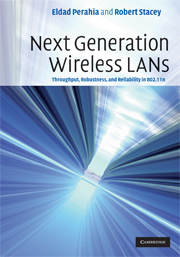Book contents
- Frontmatter
- Contents
- Foreword by Dr. Andrew Myles
- Preface
- List of abbreviations
- 1 Introduction
- Part I Physical layer
- Part II Medium access control layer
- 7 Medium access control
- 8 MAC throughput enhancements
- 9 Advanced channel access techniques
- 10 Interoperability and coexistence
- 11 MAC frame formats
- Part III Transmit beamforming
- Index
- References
8 - MAC throughput enhancements
from Part II - Medium access control layer
Published online by Cambridge University Press: 04 December 2009
- Frontmatter
- Contents
- Foreword by Dr. Andrew Myles
- Preface
- List of abbreviations
- 1 Introduction
- Part I Physical layer
- Part II Medium access control layer
- 7 Medium access control
- 8 MAC throughput enhancements
- 9 Advanced channel access techniques
- 10 Interoperability and coexistence
- 11 MAC frame formats
- Part III Transmit beamforming
- Index
- References
Summary
Early on in the 802.11n standardization process it was recognized that even with significantly higher data rates in the PHY the fixed overhead in the MAC protocol was such that little of that gain would be experienced above the MAC. It was clear, as this chapter will show, that without throughput enhancements in the MAC the end user would benefit little from the improved PHY performance.
Reasons for change
Since the original 802.11 specification was completed, a number of amendments have introduced new PHY capabilities and with them enhanced performance. In addition, the 802.11e amendment which primarily added QoS features also enhanced MAC performance with the introduction of the TXOP concept and block acknowledgment. However, these MAC performance improvements were only slight, and with the potential for significantly higher PHY performance it was soon realized that the existing MAC protocol did not scale well with PHY data rate.
Throughput without MAC changes
The poor scaling of throughput above the MAC with PHY data rate is illustrated in Figure 8.1 where the theoretical throughput is given for unicast data sent from one station to another assuming a 3 ms TXOP limit, block ack protocol, and a 10% packet error rate (PER). As the PHY data rate is increased beyond the 54 Mbps peak data rate of 802.11a/g, throughput begins to level off.
- Type
- Chapter
- Information
- Next Generation Wireless LANsThroughput, Robustness, and Reliability in 802.11n, pp. 203 - 224Publisher: Cambridge University PressPrint publication year: 2008



